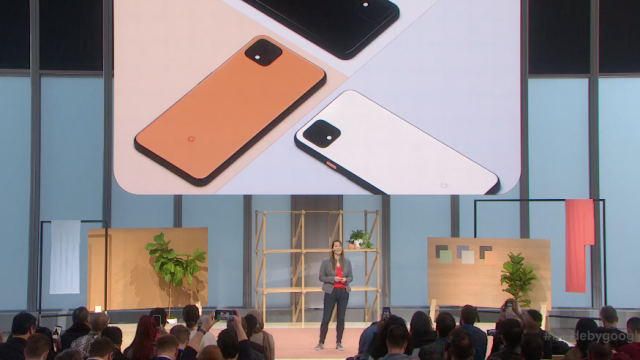Google has been working up to this for more than four months, but now it’s here, so say hello to the Pixel 4.
For its fourth-generation Pixel phone, Google changed things up a bit, not just in terms of design, but also when it comes to the Pixel 4’s features and capabilities.
So gone is the traditional two-tone colour pattern from previous models, along with the big notch on the Pixel 3 XL. And in their place, Google has upped the Pixel’s photography game with a second rear camera, refreshed its specs with faster guts and a new colour, and even added a brand new gesture recognition feature called Motion Sense.
Specs and models
OK, let’s start with the basics. Similar to previous years, the Pixel 4 will be available in two sizes: the 5.7-inch standard Pixel 4, and the 6.3-inch Pixel 4 XL, both of which sport slightly larger screens than last year’s handsets. Inside, both models will come with a Qualcomm Snapdragon 855 processor, 6GB of RAM, 64GB of storage (with a 128GB option), IP68 water-resistance, and a USB-C port for charging and data transfer.
Additionally, both phones come with what Google is calling a Smooth Display, which uses a 90Hz refresh rate (up from the standard 60Hz refresh rate you get on most phones), which should make apps, games and just generally using the phone look and feel more fluid and responsive.
The one concerning thing from a spec standpoint is the size of the Pixel 4’s battery. At 2,800 mAh, the Pixel 4’s battery is actually slightly smaller than the 2,915 mAh battery in the Pixel 3. While some power efficiency improvements thanks to the Pixel 4’s Snapdragon 855 chip should help balance out the phone’s smaller battery, it’s still not very comforting thought considering the Pixel 3’s battery life was just good, not great.
Thankfully, the Pixel 4 XL’s battery has gotten a sizable jump up from 3,430 mAh on the Pixel 3 XL to 3,700 mAh on the Pixel 4 XL, so longevity shouldn’t be a concern for the larger model.
Motion Sense
Detailed earlier this year, the Pixel 4’s new Motion Sense gesture recognition is based on tiny radar chips embedded in the Pixel’s top bezel. This allows the Pixel 4 to identify and track nearby objects like a person’s hand, so you can skips songs, snooze an alarm, or silence a call just by waving at the phone.
The idea of adding gesture recognition to phones is something other companies have tried before like on the LG G8 in the spring and even as far back as the Air Gestures on the Samsung Galaxy S4 from 2013. However, Google’s use of radar instead of cameras or 3D time of flight sensors is a new approach and could be one of the Pixel 4’s most unique and powerful features.
Cameras
For 2019, the Pixel 4 is getting a new 16-MP 2x telephoto camera in back to go with its 12-MP primary camera, though it seems this upgrade has come at the cost of the dual selfie cameras Google gave the Pixel 3, as the Pixel 4 only has single camera in front.
The Pixel 4’s 2x telephoto camera is another first for any Pixel phone and works with the Super Res Zoom feature Google introduced on the Pixel 3 to an even longer hybrid zoom. But even more important than that are all the new features and modes Google has added to the Pixel’s camera.
Alongside general speed and image quality improvements to the Pixel’s impressive Night Sight mode (which now comes with a new astrophotography mode), Google has come up with a handful of new modes including Motion Mode, Live HDR+, and even a improved selfie mode.
Motion Mode was created to help Pixel owners capture fast moving subjects better (like during a sporting event or dance recital) by maintaining a high shutter speed and allowing the camera to freeze the action.
Meanwhile, Live HDR+ is a video upgrade allowing the Pixel 4 to capture brighter, more colourful footage with high dynamic range in real time. And to make adjusting HDR photos easier, Google is adding dedicated settings for tweaking white balance and exposure. Even portrait mode is getting a upgrade by combining photo info from both rear cameras to add capture extra depth and detail to images.
Other features
Aside from the cameras, the Pixel 4 will also include IP68 water-resistance, Qi wireless charging and built- in Titan M security chip. Also, new for the Pixel 4 is a new 3D dot projector that allows for faster and more accurate face unlock.
Google also showed off the Pixel 4’s new live transcribe feature live during the launch event, which even includes the ability to search audio clips using specific keywords, right on the phone without even needing an internet connection.
Google is even tossing in three months of 100GB of cloud storage for free with a new Pixel 4.
Price and Availability
The Pixel 4 and Pixel 4 XL will be available in three colours (black, white, and a limited edition Oh So Orange) for $1,049 for the 64GB and $1,199 for the 128GB, with the XL coming in at and $1,279 for the 64GB and $1,429 for the 128GB.
